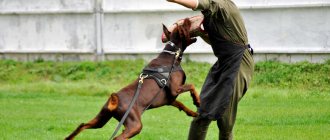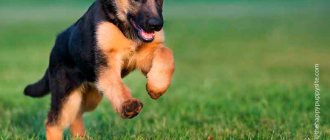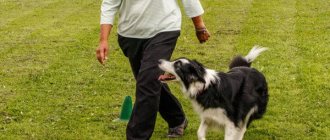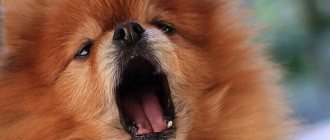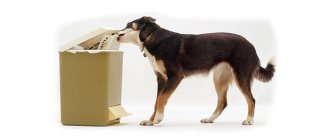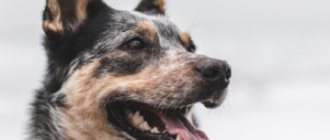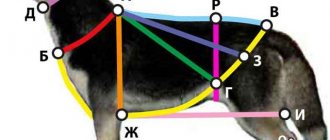At what age should you start training?
You should not try to teach anything to a puppy before three months. It's dangerous and useless. Young pets cannot concentrate on something for long enough, and the process of training at an early age is traumatic.
Do not think that it is no longer possible to raise an adult four-legged friend. The training process will require much more time and effort, but training a dog is a necessity.
Do not forget that training is a way of establishing a hierarchy between the owner and the pet, and this, in turn, is a matter of safety.
Let's sum it up
The “lie down” command, although it seems useless at first, will very soon demonstrate to you all the delights of the fact that the dog knows how to perform it, especially if you always take your dog everywhere and, for example, prefer to travel by public transport. Rest assured that your pet does not suffer from learning commands, but, on the contrary, is happy to learn them, since intellectual exercise develops dogs in almost the same way as humans, and gives them pleasure in the same way.
How to choose a place to study
It is very important that your pet feels safe and comfortable during training, so when choosing a place for training, it is worth studying its habits.
Most puppies feel comfortable around their owner, regardless of their environment. In this case, training can be carried out not only at home, but also on the street.
*It is important to consider distractions: puppies have a hard time focusing, so any little thing can become a distraction. Avoid dog parks at first.
If on the street your pet constantly clings to you, asks to be held and does not want to explore the area, then you should not try to train it outside the home. All of the above are signs of fear and anxiety.
They will not only interfere with the learning of commands, but will also lead to negative reinforcement, which will complicate training in the future. In this case, your home will be the best choice for a place to study. It is advisable to choose a room in which your pet spends most of the time. But not too close to his “place”, because the puppy’s personal space should remain a place to rest. Over time, the fear will pass, and classes can be safely transferred to open areas.
If you keep your pet in an enclosure, then under no circumstances conduct training in it. Invasion of personal space can make your pet want to dominate, making it more difficult to establish a hierarchy.
When dealing with an adult dog, pay attention to the hair near the tail and in the withers area. She stands on end when aggression occurs. Be wary at the slightest hint of this. In this case, it is better to entrust education to professionals.
Conditions for training
To train, a dog must first of all be healthy, have a good appetite and be active. If your pet is not feeling well, you should not force him to exercise, this will lead to negative reinforcement of training.
It is recommended to conduct training sessions with your dog every day, if possible, at approximately the same time. The daily and training regimen, knowing the sequence of events will help the dog tune in to training more easily.
The optimal time for training is one and a half to two hours before meals or one and a half to two hours after meals.
Eye contact is very important when training. Photo: snboles
It is important to establish eye contact between the owner and the dog; it must be concentrated on the activity.
External irritants should be avoided: extraneous noise, people, other animals. Therefore, the place for training, the training ground, must be at a sufficient distance from a noisy road. When training is carried out simultaneously by several owners with their pets, the area should be quite spacious.
What you need for training
For training you will need:
- Collar;
- Standard leash up to one and a half meters long (roulette leash is not suitable for training);
- Treat for encouragement;
- The dog's favorite toy is an option for praise;
- Training harness (as additional equipment for practicing the “Sit” command when moving);
- A strict collar is necessary only if, due to the characteristics of the breed or character, the dog does not obey and behaves aggressively.
Which delicacy to choose
First of all, the delicacy should not be harmful: cheeses, sausages, fatty meats, sweets, and pickles are excluded. At the same time, it must be tasty, the dog must want this “bait”.
Cookies are not the best choice for dog treats. Photo: gjacobs228
The animal's daily food is not used as a reward. It is optimal to use finished product treats: dried meat, tendons of proven brands, which can be purchased at a pet store. You can independently prepare diced vegetables and fruits, pieces of boiled or scalded meat that the animal loves.
The treat should be small and easy to swallow, as the goal is to train the dog, not feed it. Tidbits should be easy to store and transport, such as in a small belt pouch.
Which delicacy is better to choose?
When choosing an incentive prize, you should pay attention to the tastes of your pet. Most people prefer ready-made treats like jerky. But there are times when a dog follows commands much more willingly for a piece of fruit.
My CAO loves apples. As soon as you show her a piece, she immediately sits down and quietly waits.
But not all fruits and vegetables are created equal. There are those that can cause serious harm. Never feed potatoes, avocados, grapes or raisins.
Be careful with apples - their seeds contain cyanide, to which dogs are very susceptible.
If your pet's diet is based on dry food, do not try to use it for training. The treat should be desirable, available only after the command is completed.
Do not use sweet, salty, spicy, fried, cheeses, lard, sausages and other delights of the human diet. All this causes great harm to your pet and reduces life expectancy.
Some dog breeders use special dog cookies as a treat, containing a bunch of micro and macroelements. It is not only tasty, but also healthy: their fur is really thick and shiny.
Team benefits
To use the command correctly, it is important to know how it affects your pet. When your companion sits or lies down, his nervous system calms down. Excitation processes are inhibited. This can be useful, for example, during a severe panic attack or when weaning oneself from bad habits.
The command is also useful in everyday life. It is difficult to be on public transport without it. This skill helps develop self-control, which makes the companion generally behave calmer. Intrigued? Now let's talk about learning methods.
In everyday life
The skill of lying down on command will be useful for you and your pet on public transport, for example, on the train. In any situation where the dog must stop activity, this skill is appropriate: at an exhibition, hunting, examination by a veterinarian, etc. In addition, the “Lie Down” command is included in all disciplinary training courses and in almost all dog sports disciplines.
Laying the dog down helps to fix it in a calm position and, if necessary, leave the dog in this position for a certain time. This will make grooming, nail trimming, teeth brushing, combing and other hygiene procedures easier.
Standard
Performing at an exhibition or competition involves demonstrating commands, and if the plan is to win awards, then obedience is key. This team is included in all training course standards. The positioning is used to more confidently hold the dog when practicing discipline in the “Exposure” technique.
Planting principles
Always pay special attention to the health and comfort of your pet. But at the same time, make sure that the command is executed correctly. Relaxation during training will show your pet that he can control the process for you.
The dog should look at you when performing a command and be focused on your actions. To do this, you need to attract her attention: call her name, show her a treat, pet her.
You need to carefully monitor the correct landing. It should not be performed on the thigh (as if on the side).
The support when executing the command should be on the hind legs (bones, heel and metatarsals). Improper execution of a command can harm your health and cause discomfort.
Before you begin training, look at your dog when he is standing. You will notice that the distance between pairs of paws is greater than when your pet is sitting. This suggests that trying to simply press on the dog's sacrum to execute a command is incorrect.
There are techniques that can help you achieve the correct fit.
- Movement of the back pair . The front paws remain in place. Then with your left hand, press down on the sacrum and push it forward a little. Make sure that the distance between the paws is not too small. In this case, the dog will take an incorrect position, which will cause him discomfort.
- Movement of the front pair . This technique can be used with both a treat and a collar/leash. The back pair of paws remains in place. The front ones move. Either by moving a tasty reward or by pulling on the collar/leash. Make sure your dog doesn't sit on your thigh.
Do not use a roulette leash, only the standard version is no longer than one and a half meters. Take your pet's favorite toy with you - this can also act as a reward option, only during breaks between approaches.
How to teach a dog tricks
Most dogs, with the exception of specific breeds, love and want to be trained even as adults. What should an owner who has taught their pets all possible commands do? Move on to learning tricks! Unlike a set of commands, there are countless tricks, which allows you to diversify your pet’s leisure time.
Tricks are not required to be learned, but a dog trained in additional skills can compete in a variety of amateur and professional competitions. There are several types of dog sports where the use of tricks, synchronized actions with the owner, high jumping and unusual skills are highly valued and encouraged.
This is interesting! Dog dancing competitions are held all over the world. This sport is a great spectacle that allows you to demonstrate the synchronized work of the owner and the dog performing tricks (showing a show) to the music.
The “Bunny” trick - how to teach a dog to serve
“Bunny” or “Serve” is a command in which the dog sits on its hind legs, straightens its back and folds its front legs like a bunny. The training method is very simple - the dog is stimulated with a treat until it takes the desired position. Most dogs, other than giant breeds, have no difficulty adopting the bunny pose.
Once the Bunny trick is mastered, the dog can be taught to dance. By stimulating the pet with food stimuli, it must be forced to stand on its hind legs, that is, stretch them out. When the pet learns to maintain balance in a stance with a straight back, it is taught to spin around its axis. In theory, everything is complicated, but in practice it only takes a few days to learn the trick.
Trick "Bow"
Bow or Curtsey is a command in which the dog extends its front legs and bows its head, leaving its hind legs straight. Training is carried out through motivation with a treat or toy. Carefully supporting the dog under the belly, move the treat past his muzzle along a forward and downward trajectory (as when practicing the “Lie Down” command). When the pet stretches its paws forward, give the command “Bow” and praise the pet.
Note! A common mistake when teaching the bow trick is to give the command when the dog is stretching after sleep. Stretching after sleep is a reflex action that the dog does not associate with following commands.
Trick "Somersault"
Somersault is a command in which the dog lies down and rolls over itself. The training will take several days. A piece of treat or toy is needed for stimulation. Lay the dog down with the command “Lie down”, then, in a circular motion, place the treat behind its shoulder blades and give the command “Turl”. When reaching for a treat, the dog will lie on its side and throw its head back. Gently push your dog's front paws so that he turns over.
Once the trick is learned, you can make the task more difficult by pointing the dog in the direction in which to roll. At first, defiantly hold the treat in your hand, then use the same hand to point in the direction of the somersault. Remember to reward your dog generously and not get carried away with practicing the trick. Learning the Somersault command is quite monotonous, so two or three approaches per workout are enough.
Trick "Shame" or "It's not me"
Ashamed or “It’s not me” is a command in which the dog hides its head behind its front paw. Training can be carried out using a favorite toy, which is guaranteed to attract the pet's attention. Make the dog sit in front of you and give the command “Give me your paw.” Take your pet's paw, and with your free hand, place the toy under it. When the dog puts its head under its paw, give the command “Shame” and praise the pet.
Tip: If you plan to learn this trick with your pet, it is important not to use the word shame for its intended purpose. Many owners say to their pets: “Aren’t you ashamed?”, which attaches negative associations to the consonant word.
A step-by-step method for training a puppy and an adult dog
After you have determined the optimal landing option for you, selected a treat and chosen a place, you can begin the learning process itself. Make sure there are no other animals or people around.
You need to monitor the behavior of your four-legged friend during training. This is especially important in the case of training large breed puppies (especially herding ones, such as Alabai), since hip dysplasia is common among them. The pet should not be hungry or thirsty. The best option is to start the lesson an hour before feeding and take water with you.
Training with treats
The most common method, suitable in most cases only for puppies. In fact, this is reinforcing the team with their favorite food.
- You need to stand to the left of the dog. Her attention should be focused on what is happening, and her gaze should be directed forward.
- Take out the treat and take it in your right hand.
- Say your pet's name to get attention, then give the command "Sit!" Your voice should be clear and fairly stern.
- Let your dog see and smell the treat to get him interested.
- If you chose the first landing option, you should:
- hold a treat in front of your pet;
- make it clear that you will not give it away so easily;
- With your left hand, lightly press on the sacrum.
If you chose the second one, then you should:
- without sudden movements, raise your hand with a treat above your head;
- If the dog is interested, but does not sit down, gently press on the sacrum and make it clear that he will not receive the reward just like that.
After the dog has followed the command, praise it (“well done,” “good dog,” or a reinforcement sound), reward it, and pet it.
Continue to monitor your pet’s position for 5-7 seconds, and then command “Walk.”
Then let the dog rest for a few minutes. At first, repeat no more than three to five approaches at a time. Afterwards, when the pet follows the command perfectly, give the treat less often (every other time, then after three, and so on), but do not forget to praise and stroke it. This way, over time, your pet will wean itself off food reinforcement.
Training with a leash
An excellent option for hyperactive and adult dogs, as well as overly temperamental large breed males. Great for cases when the pet does not want to land, but is simply trying to snatch the treat.
- Place your pet to your right. Pull on the leash, but not too much.
- Attract your pet's attention by calling his name. Then turn slightly towards the dog and grab the leash with your right hand at a distance of 15-20 cm from the collar fastening.
- Give the command “Sit” and use the second landing method, pulling the leash up and back, but not too much. If the dog refuses to comply with the command, combine both methods and apply a little pressure on the sacrum. Make sure there is enough space between pairs of legs.
- If your pet is old enough or hyperactive, after boarding it is worth repeating the command again, and then praising and petting it. Don't forget about the treats.
- The dog must wait for the “Walk” command before standing up. Pause for 5-7 seconds.
If your new friend is overweight, it will be very difficult for you to cope with him. If you understand that your strength is not enough, it is better to seek help.
Gesture training
The next step on the path is to execute the command after the gesture. This will not only help you better control your pet's behavior, but will also teach him to always keep you in sight.
- Stand in front of the dog, attracting attention - say his name. Show me the treat.
- Holding the treat in your right hand, raise it to shoulder level. Command “Sit.”
- After landing, give the treat and praise.
- Hold the command and then release.
Over time, increase the distance between you to two meters. After the pet has learned to follow a command only by gesture, increase the distance and holding time again.
Gradually, the dog will have to land at a distance of 15-17 meters, and maintain it for at least 20 seconds. At this stage, you can start combining it with “Come to me!” and wait!".
Landing in difficult conditions
This is a very important stage in raising a shaggy family friend, who will teach her how to behave in difficult and dangerous situations. This will also allow you to show your pet how to behave correctly in places where dogs and people gather.
She will learn to follow commands regardless of the environment. This will help avoid unpleasant situations, such as trying to play with the neighbor's children.
You can start by sitting in a room with another person, or asking your friends to hang out with you. Then give the command when your pet is interested in the game.
Gradually move to more crowded and noisy places. Don't do this every day, but alternate it with walks in the park. But don't forget about the muzzle, especially if the dog is large.
Walking dogs without a muzzle in public places is prohibited.
If your pet has a thick undercoat, using snowdrifts as obstacles is a great way to practice the exercise in challenging environments. But remember: urban snow is doused with dangerous chemicals. It's better to go to the fields.
Reflexive execution of a command.
Perhaps this can be called the last step to the title of an exemplary dog. To master this skill, your pet must know other basic commands.
Practice the “Nearby” command for some time. It is advisable to do 2-3 approaches. Then do another one, but at the end say “Sit” and hold for 5-7 seconds. Praise, reward, take a break and repeat 2-3 more times.
Gradually increase the time, change direction when executing the “Near” command. Bring the landing to automaticity: the dog must perform it when stopping. Make sure your pet is always on the left. Try changing direction without a leash.
No less important is the connection with the “Come to me” command. Thanks to this combination, the dog will be more manageable. If you need to distract her from playing, she will not just run towards the owner and continue playing with him, but will sit next to him.
- While at a distance from the dog (at least 4 meters), give the command “Come to me” and show the treat in your left hand.
- Once your pet is close, lower your hand along your body. The dog should approach you from the left side.
- Give the command “Sit”. If this does not work, try putting your pet on a leash first.
- Praise and reward. Don't forget about endurance.
Additional tasks
After basic training, the team should move on to the next level of dog obedience.
Execute a command only by gesture
It is necessary to train the dog to follow commands using just one gesture. This skill is required not only for working dogs, but is also very convenient in everyday life. The dog will understand you from a distance, you won’t have to shout a command on the street. This skill disciplines the animal and forces it to keep its owner in sight.
They teach a gesture command in parallel with a voice command. When the dog masters the skill using methods using treats or using a leash, they move on to training using a gesture:
- Stand in front of your dog and give the command “sit” while raising your right arm forward slightly above your shoulder.
- If the dog sits, praise it.
- Hold for 5-10 seconds and command “walk.”
- Gradually move away from the dog to a greater distance and repeat the previous steps according to steps 1-3.
- When the dog learns to follow a command given both by voice and gesture, start using only the gesture.
- Gradually increase the distance to 15 meters between you and your pet when giving a command-gesture.
- Be sure to allow time after the dog sits. This time increases with the distance you move from the animal, and ideally should be at least 15 seconds.
- If, when moving away from the dog, it begins to follow you or there is no endurance in the sitting position, approach the dog and strictly command “sit”. If you refuse to obey the command, sit the animal down.
- Repeat the gesture command until the result is successful.
Following the “sit” command in a difficult environment
Once the dog has sufficiently mastered the command to sit without the presence of external stimuli, begin training in other places. This could be a sit command when walking outside, a noisier, smaller training area.
Photo: meg_nicol
The main rule: introduce such activities gradually, for example, every other day, so that the dog gets used to it and does not get nervous.
The dog's reflexive execution of the "sit" command
There are situations in which the execution of the “Sit” command is required without issuing the command itself. Training in these cases is based on the principle of performing the “Sit” command as a continuation of a specific action.
“Sit” when executing the command “nearby”
This command is required so that the dog on a walk, when you stop while moving, sits next to you and remains in place, and does not go forward. The skill is useful, for example, when crossing the road at a pedestrian crossing while you are waiting for the opportunity to cross the road or for a green traffic light.
Education:
- Walk a few meters with the dog (executing the “Nearby” command);
- Stop and give the command “Sit” with your voice, which the dog must correctly execute in compliance with the holding time;
- Over time, gradually abandon the voice command so that the animal sits on its own when you stop while walking.
Following the owner when his position changes
Knowledge and ability of this version of the “Sit” command will be useful, for example, in the case of an animal practicing professional training skills, and will also ensure that the dog remains next to you even when you move.
The dog follows the owner on the command “Sit” (video)
When mastering the skill, the dog sitting next to the owner, seeing that the person has turned to the side, gets up and takes a place at his left leg and sits down again.
Education:
- Sit the dog on your left side using the “Sit” command;
- Make a turn, and at the same time give the command “Come to me” with your voice or gesture. The dog is required to stand up and approach your left leg;
- Give the command “Sit”, ensuring that the pet performs it correctly;
- Over time, stop saying or making a gesture first of the “Come to me” command after you turn, and then gradually stop issuing the subsequent “Sit” command.
“Come to me” + “Sit”
When the previous methods of performing the skill have already been mastered, you can move on to mastering the “Come to me” command in combination with the “Sit” command. As a result of training, the animal, having received the command “Come to me,” will approach the owner and, going around him, sit near the left leg.
Knowing this complex will be useful if you need to call your dog so that after that it remains in place next to you (for example, if you notice someone else’s dog without a leash while walking, it will be easier for you to take your pet on a leash).
Education:
- Wait until the dog moves some distance away from you.
- Give the command “Come to me” and wait for the pet to approach.
- Immediately say the command “Sit”, while using a treat (or taking your pet on a leash) to get the pet to walk around you and sit next to your left leg.
- Then, in this case, gradually give up treats or use of a leash, as well as giving a command (voice or gesture).
Each new option for performing a command should be introduced into training only after the previous options have been clearly worked out, that is, if the animal does not require additional help in the form of giving intermediate commands, and each of the component parts of the command is executed clearly and correctly.
Possible mistakes
Irregular exercise can be harmful. Try to do the exercises daily.
Never use physical force when training. This is always negative reinforcement, which can cripple your pet’s psyche.
Don't use the same treat for too long. Alternate between different types. And don't use too big pieces.
Don't overexert your pet. Overtraining is overworking the nervous system. If you notice that your pet is reluctant to follow commands, postpone training until tomorrow.
Incorrect use of intonation during training will harm the result. Commands should be given clearly, quite loudly, but there should be no anger in the voice. This way your pet may think that you are scolding him. Reinforcing praise should be gentle, less loud.
Don't forget to take breaks between sets. They should be long enough for the pet to rest and get distracted. The retention should not be too long.
Don't get distracted while doing the exercises. This is an extra chance for the pet to seize the initiative. Stay focused and composed. Don't let overly energetic pets turn training into play.
Briefly about the main thing
- The “Sit” command is the first command in every dog’s life, which lays the foundation for training and behavior.
- Emotional contact and praise are important, but it is equally valuable to be strict at times.
- There is no need to act recklessly; you should pay attention to temperament and habits.
- Choose a method that suits you personally, but do not forget about the comfort and health of your pet.
- Regardless of your age, repeat the exercises at least once a week - this will preserve your skills and reactions.
- The right approach will help you become best friends and give your four-legged friend many years of happiness.
Did you like the article? Share it with your friends on social media. networks. This will help them get useful information and support our project.
Methods of training and giving commands
There are proven, old-fashioned training methods that involve the use of carrots and sticks. If the dog obeyed, it was rewarded; if it disobeyed, it was punished. Despite their proven effectiveness, such dog training methods have long been discouraged and not used in many countries.
This is interesting! Modern dog trainers are trying to develop the most humane methods for training dogs.
Depending on the temperament and characteristics of your pet, you need to choose the most effective motivation methods:
- Food.
- Toy or game.
- Positive emotions.
Food irritants affect almost all dogs, especially during puppyhood. Stimulation with a toy or game is great for dogs with active temperaments and alert minds. Positive emotions are the best reward for a dog, especially if it has an innate companion nature.
The methods for issuing commands also differ. In everyday life, dogs are given commands by voice or gesture. If a dog has poor hearing or cannot hear at all, it is trained only with gestures and vibration signals. Active service breed dogs are trained to follow commands using a whistle and clicker.
Following a command given by voice is considered mandatory if the dog hears it. In case of bad weather conditions or a significant distance between the dog and the owner, it is trained to carry out commands given by gestures. Clickers and whistles are used when participating in competitions and training herding and guard dogs.
